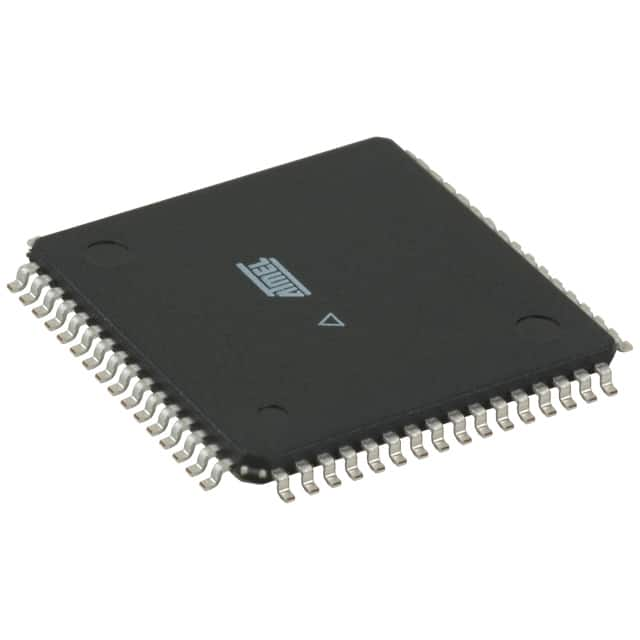ATSAMD21J16A-AU
Product Overview
- Category: Microcontroller
- Use: Embedded systems, Internet of Things (IoT) devices, and other applications requiring a high-performance microcontroller.
- Characteristics: Low power consumption, high processing speed, extensive peripheral integration, and advanced security features.
- Package: TQFP (Thin Quad Flat Package)
- Essence: The ATSAMD21J16A-AU is a 32-bit ARM Cortex-M0+ microcontroller that offers a wide range of features and capabilities for various applications.
- Packaging/Quantity: Available in tape and reel packaging with a quantity of 2500 units per reel.
Specifications
- Architecture: ARM Cortex-M0+
- CPU Speed: Up to 48 MHz
- Flash Memory: 256 KB
- SRAM: 32 KB
- Operating Voltage: 1.62V to 3.63V
- Digital I/O Pins: 32
- Analog Input Pins: 14
- UART/SPI/I2C Interfaces: Multiple
- ADC Resolution: 12-bit
- PWM Channels: 6
- Timers: 6
- Communication Protocols: USB, CAN, LIN, I2S, IrDA, and more
- Security Features: Hardware-based cryptographic acceleration, secure boot, and tamper detection
Pin Configuration
The ATSAMD21J16A-AU microcontroller has a total of 64 pins, which are assigned to various functions such as GPIO, analog inputs, communication interfaces, timers, and more. For a detailed pin configuration diagram, please refer to the datasheet provided by the manufacturer.
Functional Features
- High-performance ARM Cortex-M0+ core for efficient processing.
- Low power consumption for extended battery life in portable devices.
- Extensive peripheral integration allows for simplified circuit design.
- Advanced security features ensure data protection and system integrity.
- Flexible communication interfaces enable seamless connectivity with other devices.
- Rich set of timers and PWM channels for precise timing control.
Advantages and Disadvantages
Advantages: - Powerful processing capabilities suitable for a wide range of applications. - Low power consumption extends battery life in portable devices. - Extensive peripheral integration simplifies circuit design. - Advanced security features protect sensitive data. - Multiple communication interfaces enable seamless connectivity.
Disadvantages: - Limited memory capacity compared to some higher-end microcontrollers. - Higher cost compared to entry-level microcontrollers. - Steeper learning curve for beginners due to the complexity of the ARM architecture.
Working Principles
The ATSAMD21J16A-AU microcontroller operates based on the ARM Cortex-M0+ architecture. It executes instructions stored in its flash memory, processes data, and interacts with various peripherals and external devices. The microcontroller's working principles involve fetching, decoding, and executing instructions to perform specific tasks as programmed by the user.
Application Field Plans
The ATSAMD21J16A-AU microcontroller finds applications in various fields, including but not limited to: - Internet of Things (IoT) devices - Home automation systems - Industrial automation - Wearable devices - Consumer electronics - Robotics - Automotive electronics
Alternative Models
- ATSAMD21G18A-AU: Similar features and specifications with a lower memory capacity.
- ATSAMD51J19A-AU: Higher performance and more advanced features with a higher price point.
- STM32F030C6T6: An alternative microcontroller from a different manufacturer with comparable specifications.
Note: This is not an exhaustive list, and there are several other alternative models available in the market.
Word count: 409 words
Senaraikan 10 soalan dan jawapan biasa yang berkaitan dengan aplikasi ATSAMD21J16A-AU dalam penyelesaian teknikal
Sure! Here are 10 common questions and answers related to the application of ATSAMD21J16A-AU in technical solutions:
Q: What is the ATSAMD21J16A-AU microcontroller used for? A: The ATSAMD21J16A-AU is a microcontroller commonly used in various technical solutions, including IoT devices, wearables, industrial automation, and consumer electronics.
Q: What is the maximum clock speed of the ATSAMD21J16A-AU? A: The ATSAMD21J16A-AU can operate at a maximum clock speed of 48 MHz.
Q: How much flash memory does the ATSAMD21J16A-AU have? A: The ATSAMD21J16A-AU has 256 KB of flash memory for program storage.
Q: Does the ATSAMD21J16A-AU support analog-to-digital conversion (ADC)? A: Yes, the ATSAMD21J16A-AU has a built-in 12-bit ADC with up to 20 channels for analog sensor interfacing.
Q: Can I use the ATSAMD21J16A-AU for low-power applications? A: Absolutely! The ATSAMD21J16A-AU features multiple sleep modes and power-saving techniques, making it suitable for low-power applications.
Q: Does the ATSAMD21J16A-AU support USB connectivity? A: Yes, the ATSAMD21J16A-AU has a full-speed USB interface, allowing for easy communication with other devices.
Q: Can I use the ATSAMD21J16A-AU for real-time applications? A: Yes, the ATSAMD21J16A-AU includes a real-time counter (RTC) and various timers, making it suitable for real-time applications.
Q: What development tools are available for programming the ATSAMD21J16A-AU? A: There are several development tools available, including the Arduino IDE, Atmel Studio, and various third-party IDEs that support the ATSAMD21J16A-AU.
Q: Can I use the ATSAMD21J16A-AU with other microcontrollers or communication protocols? A: Yes, the ATSAMD21J16A-AU supports various communication interfaces like I2C, SPI, UART, and can be easily integrated with other microcontrollers or communication protocols.
Q: Is the ATSAMD21J16A-AU a cost-effective choice for my project? A: Yes, the ATSAMD21J16A-AU offers a good balance between performance and cost, making it a popular choice for many technical solutions.
Please note that these answers are general and may vary depending on specific requirements and use cases.


